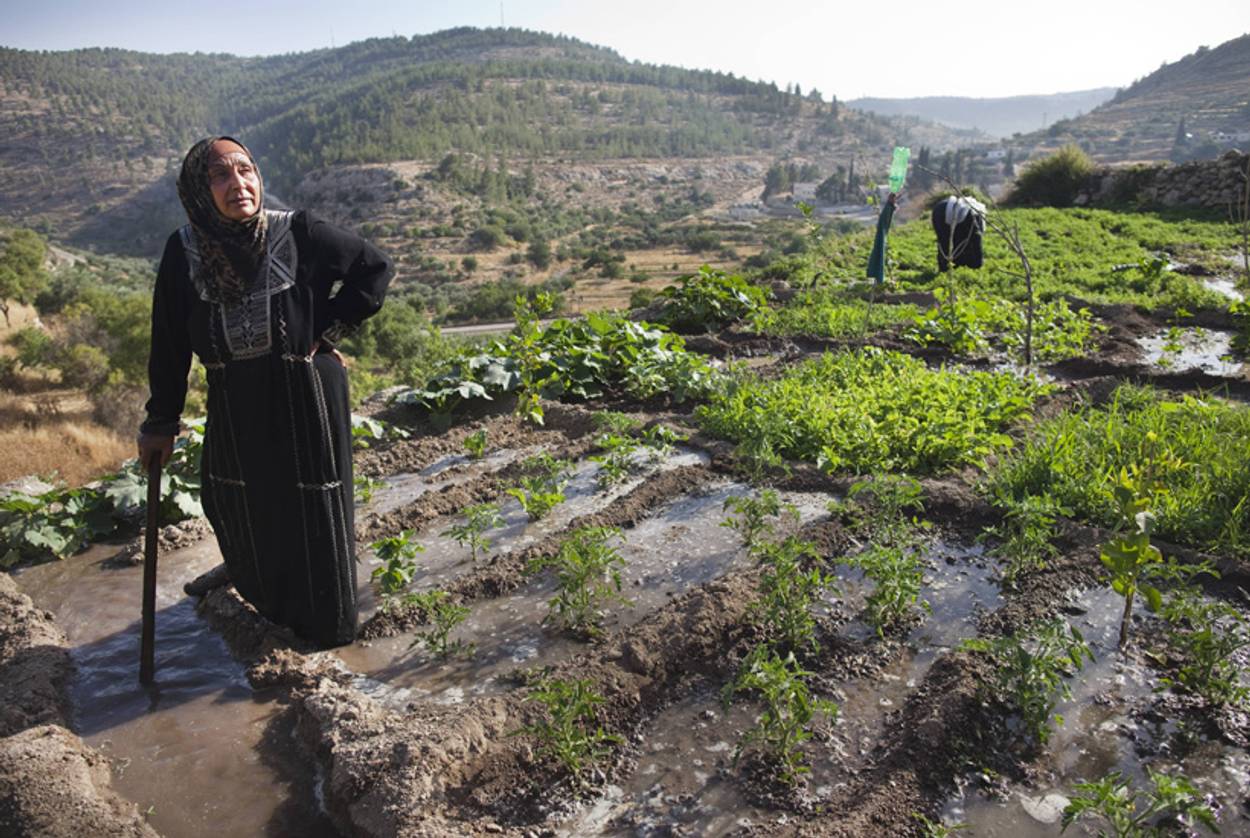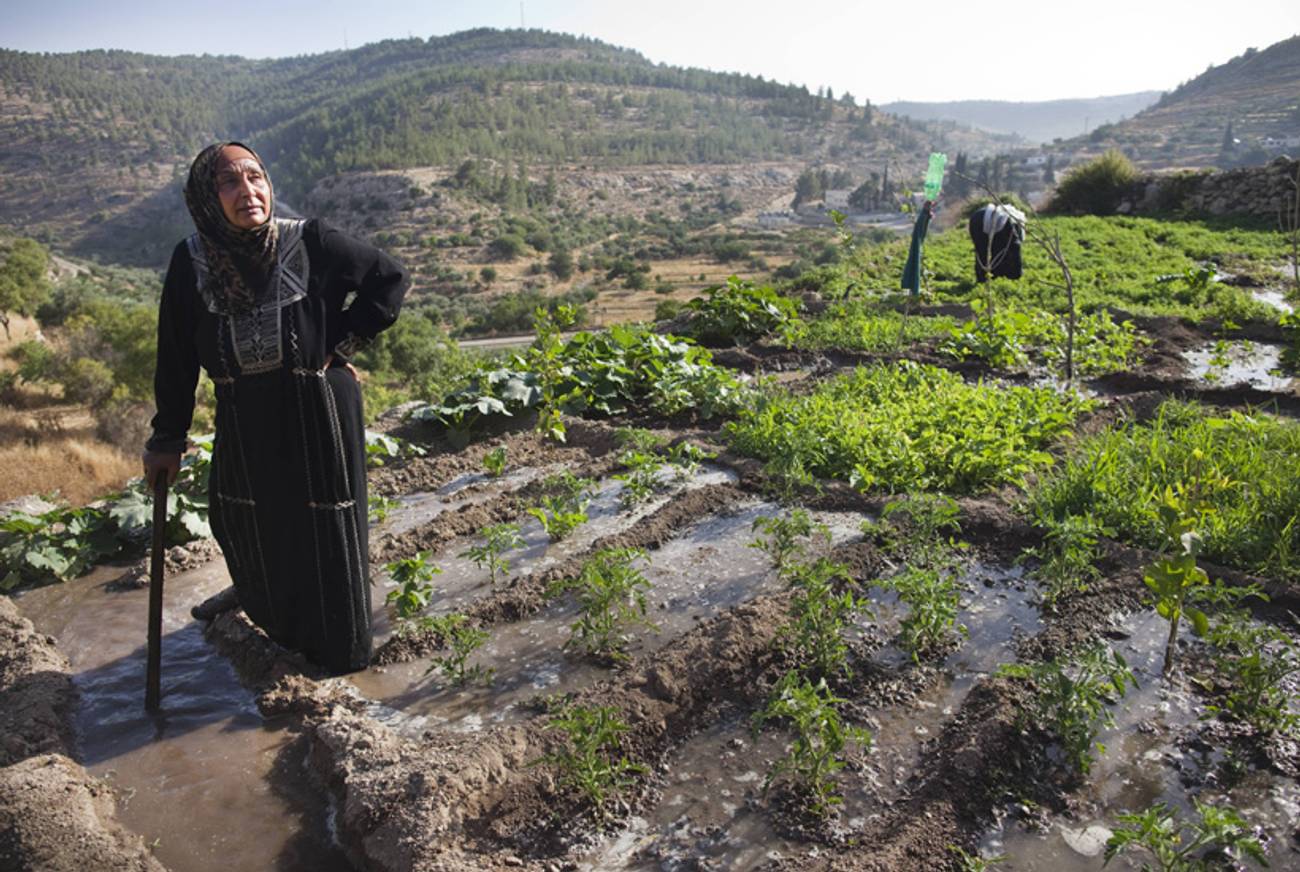Land for Peace in the Battle Over Millennia-Old Palestinian Farming Terraces
In the village of Battir, green ideals and cultural heritage override detailed plans for Israel’s separation wall




Drive into the village of Battir on a weekday afternoon, and among the kids playing soccer in the streets and the lush fig trees outside modest homes, you are likely to see an old man or woman walking toward the fields, an antiquated hoe in hand. They are farming in the hundreds of acres of terraces watered by a Roman-era irrigation system. On a recent Tuesday, Battir Mayor Akram Bader showed me around the village fields. Water gushed into a Roman spring at the top of the farmland and gurgled from there to a large pool that feeds a network of pipes and channels that descend the stepped land. Water is divided among the villagers by clan. Each day, an old man clambers into the pool and measures the water, allotting one of the eight extended families who live there the right to water their fields from sunrise to sunset. They use rocks and cloths to guide the flow onto terraces plowed into mazelike furrows, a system that irrigates tall and ancient fig trees, aromatic mint, and seedlings of eggplant, a local specialty.
“I don’t know how many thousands of people passed here,” Bader said. “When I walk here, I think about all the years and the huge number of people who used this path to make their way.” In fact, the irrigation system is so extensive and unusual that in 2011 Battir won a $15,000 prize from the U.N. cultural body UNESCO for the “Safeguarding and Management of Cultural Landscapes.” The most ardent managers of that land are weathered farmers in their sixties and seventies, undeterred by the steep stone steps they must climb to tend their tiny patches of vegetables.
For the past few years, Battir’s residents feared their 4,000-year-old farming heritage would soon hit a wall—because of the Israeli army’s plan to build a wall across their fields as part of the separation barrier between Israel and the West Bank. But a coalition of Palestinian and Israeli environmental activists, helped by an unlikely partner in the Israeli government, protested the route in Israel’s High Court of Justice and earned an injunction against the plan. It was a rare win for environmental concerns in the discussions around the barrier, and it showed both the power and the limits of green ideals when facing off against security concerns in Israel.
***
Because Battir is a border community, its survival as an intact farming village is a historical anomaly. In 1949, as Israel and its Arab neighbors signed a ceasefire agreement, what became the border between Israel and Jordan ran between dozens of farming villages and their land. Nearly all the West Bank villages with land in what became Israel lost that territory. Battir, though, was different. Then-Defense Minister Moshe Dayan offered Battir’s residents a deal: They would protect the train track that ran across their fields, and in exchange they could keep tending their terraces that ran in both the West Bank and Israel.
Six decades later, the train still chugs through the valley, with an Israeli jeep sweeping the tracks just ahead of it and an army watchtower overlooking from a nearby hilltop. But an official at the Defense Ministry, who spoke on condition of anonymity, said this arrangement is not enough to keep out potential hostile infiltrators, and the gaping hole in the separation barrier is a breach in security that must be fixed.
Israel began building the separation barrier in 2003 in response to a wave of deadly Palestinian attacks on Israeli cities. The barrier, part fence and part wall, snakes around the West Bank border and has been credited by some Israeli military experts with bringing down hostile attacks inside Israel. But Palestinian critics point out that the wall often diverts to include settlement blocks, and about 8.5 percent of the West Bank has been included on the “Israeli” side of the barrier. According to Shaul Arieli, an Israeli expert on the barrier, it is about 845 kilometers long, and two-thirds has been built. Many of the unbuilt sections, including the one that would pass through Battir, are locked in legal battles.
One of the most famous cases is that of the village of Bil’in, in the northern West Bank. The fence built there initially took half the village’s land, but in 2007 the Israeli High Court ruled the fence had to be moved. Three years later, the army moved the barrier westward. Other villages are not so lucky. Walajeh, a village just south of Jerusalem, is now being surrounded by a concrete wall and fence on all sides, and Israeli courts overruled their objections. The Cremisan Monastery to Walajeh’s south will also lose land to the wall.
Battir is part of a cluster of farming villages that includes nearby Wadi Fuqin, another picturesque hamlet with old men kneeling over onion patches. For the last 10 years, Israelis and Palestinians have been coordinating joint environmental activities through Friends of the Earth Middle East, an organization with offices in Tel Aviv, Bethlehem, and Amman. Australian-Israeli founder Gidon Bromberg says activists in Wadi Fuqin fought against a wall planned on their land and then told his office about Battir’s struggle to maintain its fields.
“We understood the incredible value of the Battir landscape, that it was the most perfect, intact, man-made landscape of the area,” Bromberg said. He and FoEME’s attorney Michael Sfard filed suit in the High Court of Justice, claiming the fence would have to be moved to preserve the land. They had heard rumors that the Israel Nature and Parks Authority, which approved the fence’s original route in 2005, might have had a change of heart eight years later. So, Sfard included the INPA in the lawsuit. In its 13-page policy paper, the INPA stated it had changed its mind and that the urgent security climate that once made them quick to approve security measures had grown less threatening. Furthermore, Battir’s terraces, the authority claimed, were also an Israeli heritage site and should be carefully safeguarded.
Yuval Peled, director of planning at the INPA, said he headed a study on cultural landscapes in Israel, completed two years ago. “Our perspective on the works of man in nature is changing,” he said. In past projects, including the Jerusalem-Tel Aviv railway extension, “we could have done better. But now we are in a situation where we understand more.”
Asked about other cases, like Walajeh, Peled said, “In Walajeh, we were alone with the Ministry of Defense. But in Battir, there were many more people involved. We could influence more.”
This affidavit was one of four expert opinions that contended the fence would decimate the unique farming system. Alongside the legal struggle, FoEME brought Israelis to hike in the forested hills around Battir and to enjoy an afternoon concert by Israeli singer Achinoam Nini in view of the terraces. Ultimately, the court ruled in early May that the defense ministry must explain “why should the route of the Separation Barrier in the Battir village area not be nullified or changed, and alternately why should the barrier not be reconfigured.”
Bromberg sees the story of Battir as an unadulterated success. “It’s a precedent that security doesn’t automatically trump,” he said, speaking of the court’s consideration. “The court is saying security issues must be considered but must balance with other considerations.”
Mayor Bader, too, said he felt an enormous sense of relief. “Now I feel better because they avoid the idea to make a closure for our lands and destroy this heritage site,” he said. “Also we have more supporters from both sides, from the Israelis, Palestinians, and all over the world.”
But other Palestinian environmentalists had mixed feelings. In the Bethlehem offices of the Applied Research Institute–Jerusalem, researcher Jane Hilal said the case of Battir was problematic. About 170 villages have been compromised by the barrier, she said. In the northern West Bank, the barrier cuts roughly through one forest and leaves another forest entirely in Israeli hands. A real victory would be to remove the wall altogether. “It’s not a success story,” Hilal said. “If they want to not destroy the terraces, they will destroy other people’s land.”
Sfard, who also litigated the Bil’in case, said he sued the state in 2003 and claimed the whole barrier was illegal. The court ruled that any objections would have to be on a case-by-case basis, he said. “There were about 100 cases on different segments of the barrier,” he said. “There were about six or seven victories. But in general, the route of barrier has changed considerably from a route that should have encircled 20 percent of the West Bank to a route that today encircles 8.5 percent.”
Sfard said he doubted he could revisit older cases in court and move the barrier in the name of environmental and cultural heritage now. In Walajeh, Ahmad Shehadeh, who coordinates a local theater, said that “the wall is making us feel like we are animals living in a zoo.” But, he said, he had no hard feelings for Battir’s residents. “These are my people there, my friends and my brothers,” he said.
For now in Battir the feeling is euphoria. The Defense Ministry has until July 2 to submit a new idea for securing the border that will not destroy Battir. Residents are getting ready for the annual summer eggplant festival. The Palestinian Authority has placed Battir on a tentative list seeking UNESCO World Heritage Site status. Bromberg says that the Israelis on the other side of the border, where the terraces continue, are considering submitting a joint request to the U.N. body, turning a thorny dispute into a platform for cooperation.
Thinking about the rare success in Battir, Bromberg said other failed attempts to protect land from the barrier are “extraordinarily tragic. It’s a failure of those responsible for nature protection not to have raised their voices earlier, but thank goodness they did it now. We could have lost Battir.”
***
Like this article? Sign up for our Daily Digest to get Tablet Magazine’s new content in your inbox each morning.
Daniella Cheslow is an American journalist covering the Middle East.
Daniella Cheslow is an American journalist covering the Middle East.